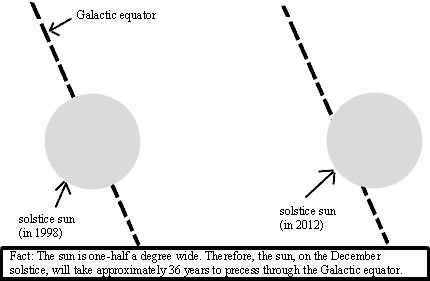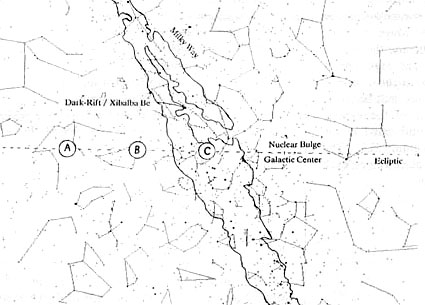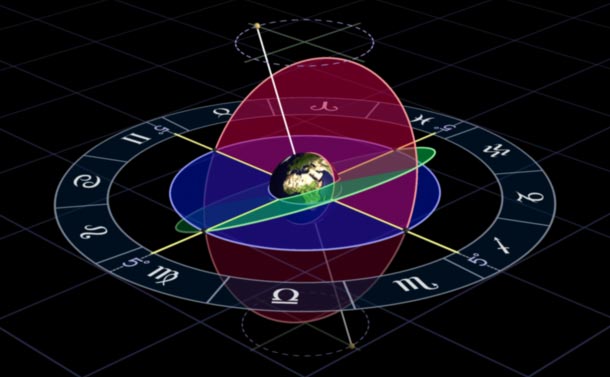|

by John Major Jenkins
from
Alignment2012 Website
It is important to define what the
Galactic Alignment is in precise astronomical terms. (See the
Glossary below for terms.)
The Galactic Alignment is the alignment of the December solstice sun
with the Galactic equator. This alignment occurs as a result of the
precession of the equinoxes.
Precession is caused by the earth wobbling very slowly on its axis
and shifts the position of the equinoxes and solstices one degree
every 71.5 years. Because the sun is one-half of a degree wide, it
will take the December solstice sun 36 years to precess through the
Galactic equator (see diagram below).
The precise alignment of the solstice point (the precise
center-point of the body of the sun as viewed from earth) with the
Galactic equator was calculated to occur in 1998 (Jean Meeus,
Mathematical Astronomy Morsels, 1997).
Thus, the Galactic Alignment "zone" is 1998 +/- 18 years = 1980 -
2016. This is "era-2012."
This Galactic Alignment occurs only once every 26,000 years, and was
what the ancient Maya were pointing to with the 2012 end-date of
their Long Count calendar.

These are the astronomical facts of the matter.
From a larger
perspective, we can visualize the 2012 Galactic Alignment in the
following way:

Position A is where the December solstice sun was in relation to the
Milky Way some 3,000 years ago.
Position B is 1,500 years ago. And
position C is "era-2012", when the December solstice sun has
converged, as a result of the precession of the equinoxes, with the
exact center-line of the Milky Way (the Galactic equator).
Notice
that the place of alignment is where the 'nuclear bulge' of the
Galactic Center is located.
A long awaiting digital portrayal of precession and galactic
alignments is now available on
Nick Fiorenza's web site.

Click above image to
watch movie clip

Descriptions of the process are also there, but it should be noted
that Nick describes what I refer to as "the solstice-galaxy
alignment" with a preference for the equinox as the measuring
reference.
Thus, he speaks of the "Holy Cross" of the equinox axis
and the Milky Way. The point is that "solstice-galaxy alignment" and
"equinox-galaxy cross" refer to the same event.
It is my hope that the these definitions will help to standardize
the terminology so we can clearly discuss the rare precessional
alignment that culminates in era-2012.
Glosary
-
The ecliptic:
The path followed by the sun, moon, and planets. It is
the plane of our solar system. The ecliptic encircles the earth and
is divided into twelve constellations, or zodiac signs.
-
The Milky Way:
The bright band of star that our solar system belongs
to. It encircles the earth and is wider in the region of Sagittarius
because that is where the 'nuclear bulge" of the Milky Way's center
is located (our Milky Way is saucer shaped).
-
The Galactic equator:
The precise mid-line running down the Milky
Way. Analogous to the earth's equator, it divides the galaxy into
two hemispheres, or lobes.
-
The Dark Rift in the Milky Way:
A feature caused by interstellar
dust that runs along the Milky Way from the Galactic Center
northward past the constellation of Aquila.
-
The December solstice sun:
The sun, on the December solstice. It is
one-half of a degree wide.
-
The December solstice point:
The precise midpoint of the sun, on the
December solstice.
-
The Precession of the equinoxes:
The earth wobbles very slowly on
its axis and this causes the position of the equinox to shift
backwards, or precess, through the signs of the ecliptic at the rate
of one degree every 71.5 years. The full precessional wobble is
complete in roughly 25,800 years.
-
The vernal equinox point
is defined by the intersection of the
ecliptic and the celestial equator.
-
The Celestial Equator:
The earth's equator projected into the stars.
It is the plane of the earth's rotation.
-
The Cross formed by the Milky Way and the ecliptic:
Exactly as
stated. There are two of these, one in early Sagittarius, the other
in early Gemini. The former cross has the virtue of being located
within the nuclear bulge of the Galactic Center.
-
The nuclear bulge / the Galactic Center:
A bright and wide region of
the Milky Way, visible to the naked eye and between Sagittarius and
Scorpio. The more precise and abstract center-point of the nuclear
bulge is the precise Galactic Center, located at about 6 degrees
Sagittarius (sidereal) and 27 degrees in the tropical zodiac.
Additional Glossary of Mayan Calendar terms
We can have a more general discussion of galactic alignments in
history if we consider that the solstice axis aligns with the
galactic equator every half precession cycle.
Likewise, the equinox
axis aligns with the galactic equator every half precession cycle.
Thus, galactic alignments, more generally speaking, occur in era
2012 (1980 - 2016) and every quarter precession cycle before and
after era 2012.
In terms of Mayan astronomy and mythology, the
Dark Rift feature
(which the Maya called the Black Road or Xibalba be) lies along the
galactic equator (the Milky Way) in the place where the December
solstice sun will be in 2012. (More precisely, the December solstice
sun will reach the southern terminus of the Dark Rift, where it
touches the ecliptic in Sagittarius.)
Thus, in terms of Mayan
mythology, we can also describe the Galactic Alignment of era-2012
as the alignment of the December solstice sun and the Dark Rift.
This entire region is targeted by the cross formed by the Milky Way
and the ecliptic between Sagittarius and Scorpio.
This Cross was
also recognized by the Maya, and was called the Crossroads or
Sacred
Tree. This entire region is embraced by what astronomers call the
'nuclear bulge' of the Galactic Center—the center of our Milky Way
galaxy. As any amateur astronomer or naked-eye star gazer knows,
this nuclear bulge is recognizable without the aid of radio
telescopes. It is wider and brighter than other parts of the Milky
Way.
So, in a general sense we can also say that
the alignment in
2012 is an alignment between the December solstice sun and the
Galactic Center. However, since the nuclear bulge is quite large,
this definition is not as precise as saying "the alignment of the
December solstice sun with the Galactic equator", which occurs in
the range 1980 - 2016.
This is the alignment zone I refer to with
the term "era-2012."
|




